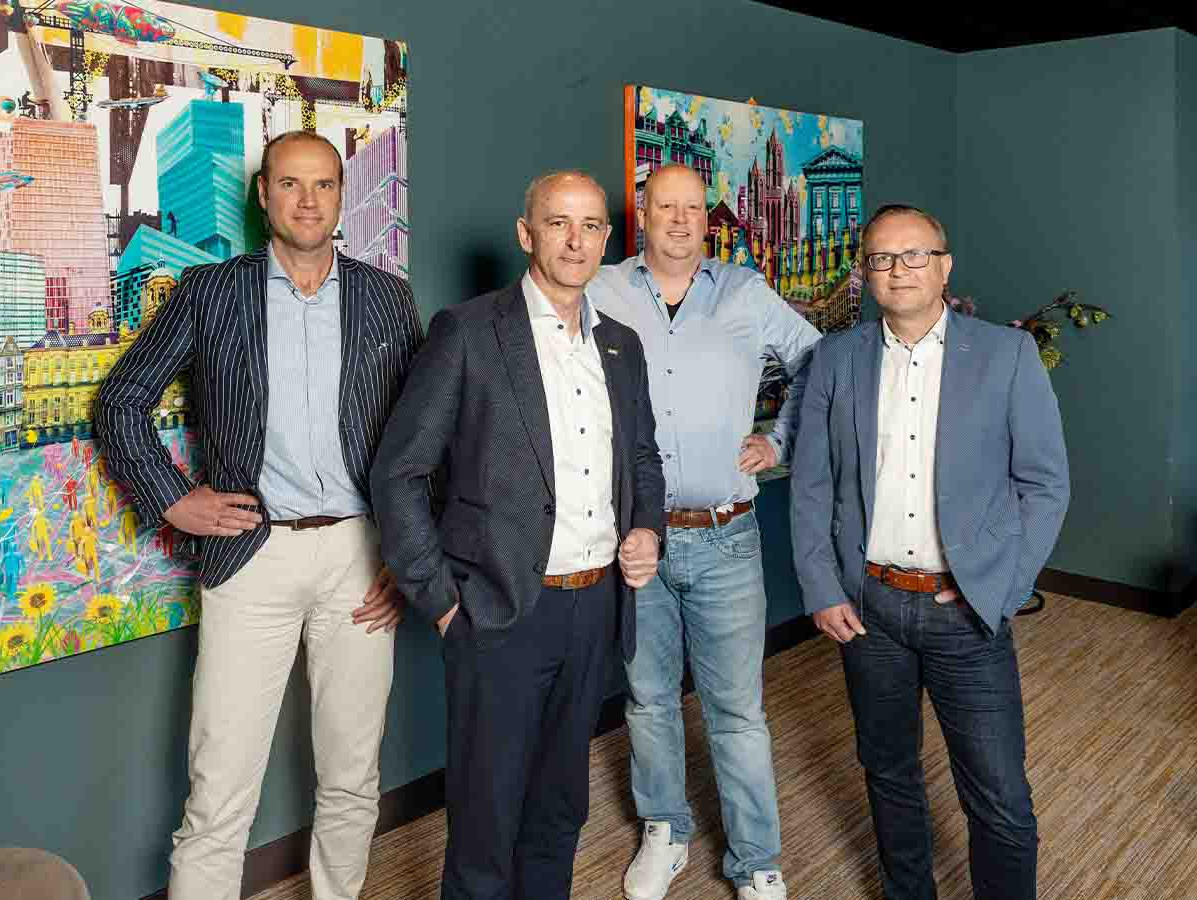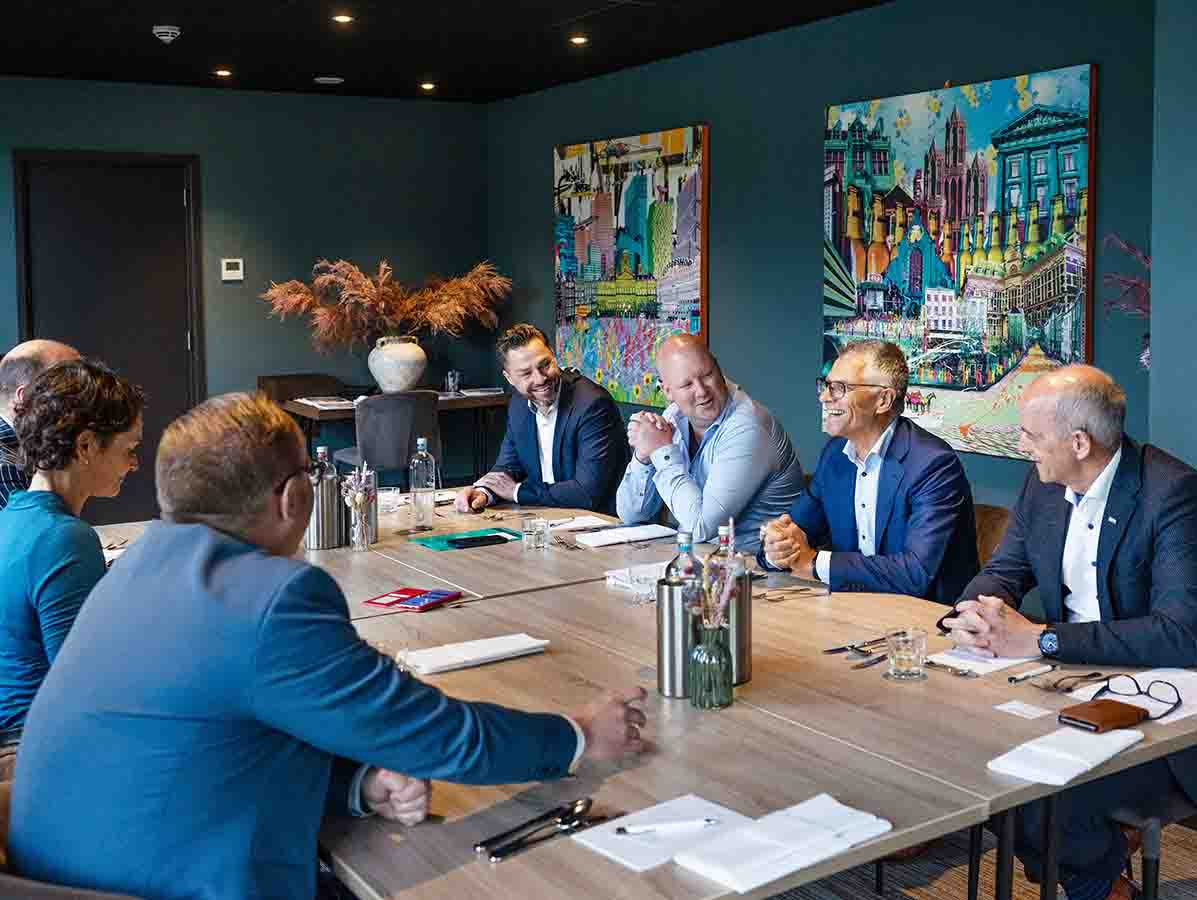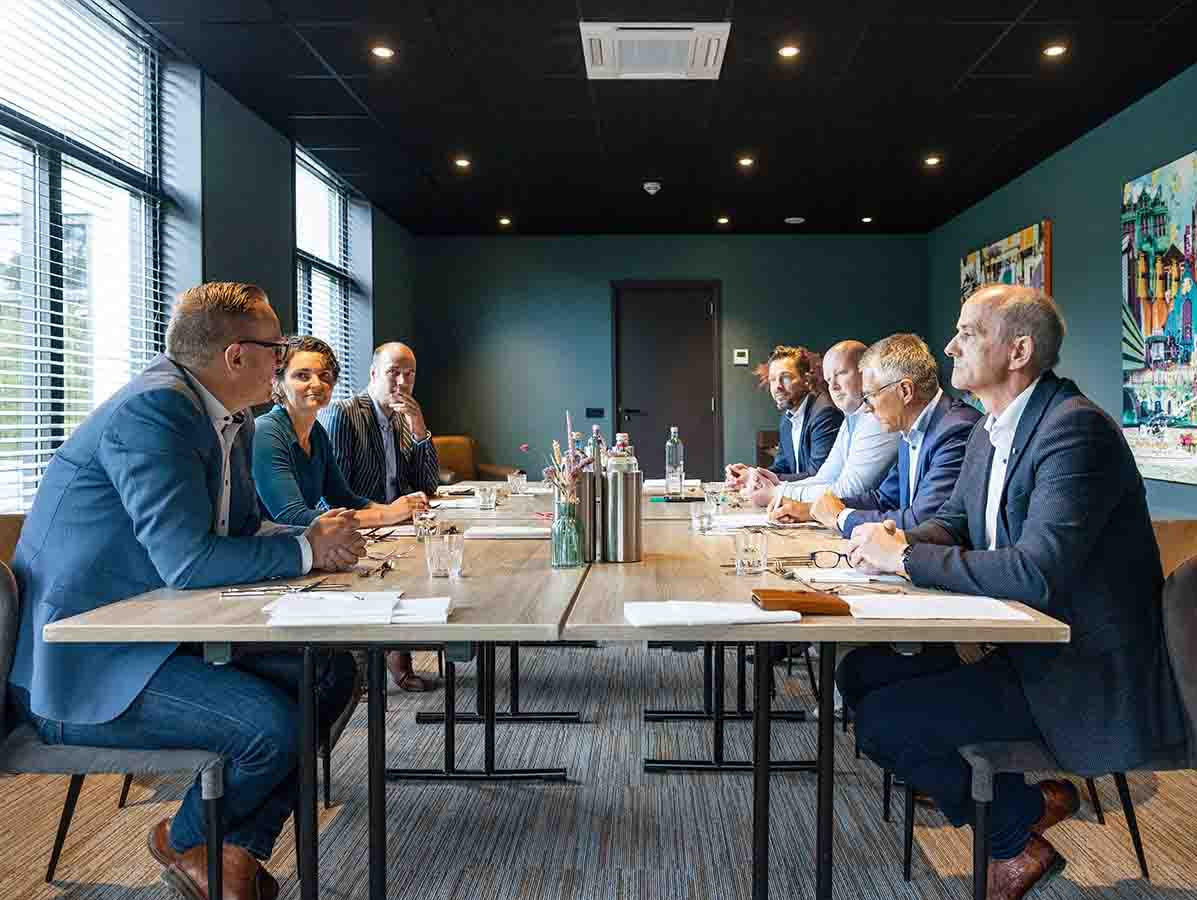
Put three family business owners in the food industry - all three of them growing - and a director of an engineering firm together at a table, serve a nice lunch, and you will get an interesting insight into the dynamic world of construction and renovation: including the dilemmas and interlaced with crazy anecdotes. A review of a "round" table discussion.
Seated at the discussion and dining table are Roelof Knijn, Jeroen van der Post, Jelle van Veen and Theo Vliek. They are invited by ING and Vakblad Voedingsindustrie. A bank and a trade magazine: whoever observes will mainly see the differences. But there is also an important similarity: Ceel Elemans (sector specialist Food), Seine Ligtenberg (director Trade & Retail and Food & Agri, North-East Region) and Judith Witte (editor in chief) want to bring people together, share knowledge, learn from each other and from each other's experiences.
Roelof Knijn is general manager of the family business Holiday Ice. The ice cream producer from Sint Nicolaasga specializes in producing popsicles and cornettos under private label.
Jeroen van der Post has final responsibility for Compaxo Vleeswaren in Gouda. Both traditional and contemporary meat and vegetarian products are produced there. Since 2019, the fifth generation has been in charge there.
Together with his brother, Jelle van Veen is CEO of Dayseaday in Urk. Annually, the company processes and trades some 50,000 tons of fish; in the broadest sense of the word. The second generation has now entered the family business.
Theo Vliek is director and one of the owners of the RBK Group; an engineering firm specializing in integral development, design and supervision of the construction of food companies (including Holiday Ice). They also provide it-solutions for those companies (such as at Compaxo Zevenaar).
"The oldest part of our site in Gouda is already 72 years old," Jeroen explains, "We have grown over the years into a 50,000 square meter factory. The site is completely covered with buildings, not ideal if you have many process flows going through the factory like we do. And as soon as we finish at the front, we can start again at the back. We have been investing a lot in recent years. Part of that is making up for lost time, part of it is turning a backlog into a head start. The first thing we built was an experience center, to accommodate guests in a nice, functional space. When that was finished, I immediately thought: not only should my guests look nice, so should my own people. And so we took everything in the factory, the offices and canteens, to a higher level. There is always room for improvement."
"We were located in the center of Spakenburg with our company, in a somewhat outdated rental building," Jelle replied. "We didn't want to spend too much on that. In order to continue to meet all the requirements, we decided to build something new in the outlying area, and do that as sustainably as possible. Last year we built a whole new salmon production line on Urk. In addition, we are building in Bucharest."
Holiday Ice's motivation is growth as well as more continuity in the company. Roelof: "We wanted to be able to pre-produce more. For that we need to be able to put our stock away in the right place at the lowest possible cost. That is becoming increasingly difficult. Two years ago we got the chance to buy the neighbor's premises. You only get an opportunity like that once, so we took it. The outside of the building remained, but inside we completely stripped it and isolated it anew. We laid a new floor and installed a completely new refrigeration system. Outside, three additional loading docks were built and all processes were automated as much as possible. It was a huge project. But also relatively simple. The 16-meter connection between our building and the new location did not open until everything was finished. Production could continue as usual during construction."
A cost price that is too high compared to the market can also be a good reason for relocation or new construction, says Theo: "With better logistics you can reduce your cost price. Optimal logistics is of course easier to design in a new building than in an existing building. Still, we always design 'the ideal factory' first. Next, we look at how that ideal situation can be implemented in the real world; whether that is new construction, or in an existing building. The goal is to get as close to the optimum as possible."

The right side of the table: From left to right: Seine Ligtenberg (ING), Jeroen van der Post (Compaxo), Ceel Elemans (ING) en Jelle van Veen (Dayseaday). The opposite side: Roelof Knijn (Holiday Ice) Judith Witte (Vakblad Voedingsindustrie), Theo Vliek (RBK)
Roelof: "Every project is different, they can't really be compared. If I have to mention something, it is that we used to organize everything ourselves. With the last project, I took on part of it. That saved a lot of time! It was mainly about coordination, and putting theory into practice more efficiently."
Jeroen: "We have 5,500 kilowatt-hours of cooling equipment on the roof. Before, all the heat went to waste. Now we are installing miles of piping, and we are adding heat pumps on the roof to recover that heat. With the energy we generate, we can run our climate chambers 24/7. We hope to save between 60 and 70% of gas by doing this."
"Recognizable," responds Jelle. "We too did not use the waste heat released from all our machines. We are going to start doing that now, also with heat recovery and solar panels. That will result in substantial savings of easily 50 to 60,000 euros per year. However, that is still not enough for all processes. Even now as we are already building, the question is: will we get enough power in time?"
Theo: "Crucial, partly for this reason, is integral project design. There are many parties at work on the construction site, all specialized in their own field. They often communicate insufficiently with each other, living on their own little island. But someone needs to know the big picture, which is essential if you want to properly integrate things like production logistics, building and building-related installations. Imagine a cooling system combined with heat recovery, or solar panels that can make a cooling system run harder when the sun shines."
Jeroen: "This is exactly why I no longer engage with multiple parties if they don't give each other responsibility, or don't want to take it. I have bumped my head several times in the past because of that. At the start of every project I always appoint one person with final responsibility."
Theo laughs: "Moreover, it works better if there is a clear plan, and everyone knows how you are going to execute it. The preliminary work has to be done. You make the important decisions while sitting at a table, not at the construction site with your boots in the mud."
Roelof: "Sure, if you have the time, you have to take it. But if you start engineering everything first, that's three years away! Sometimes a quick decision is decisive, you just have to do it, like we did with the neighbor's building. Time is money."
Jeroen: "Agreed Roelof. We are working on a mega heat pump installation on the roof. All compressed air and cooling systems will be connected to it. There are miles and miles of piping across the roof to get that done. If I wanted to prepare that project properly, I would have had to spend a year and a half on it. You consider the ROI of your projects, calculate with current energy and gas prices, but what will they be a month from now, or six months from now? The world is changing rapidly, everything is getting more expensive. Every month I wait will cost me money. Every day you save in such a project is profit. I don't mind if that means it's a little less pretty."
Jelle: "The time factor is a tricky one, though. It is increasingly difficult to find enough well-qualified personnel. On the construction site we see a lot of foreigners. I am not saying that they are not professionals, but the language barrier regularly causes communication problems, sometimes mistakes and partly because of that delays. In addition, the government needs a lot of time for granting permits. The whole nitrogen issue is also a delaying factor. New construction projects in particular have come to a standstill."
"I don't think that the permit process is disappointing yet," Jeroen countered. "Yes, they are slow processes, but you already know that in advance. Of course there are bumps in the road, but our experience is that we always manage to overcome them. Especially if you manage as much as possible; make sure that the smell emission improves, noise pollution decreases, you emit demonstrably less CO2; in short, that the neighborhood is satisfied. That really helps."
"We invited the fellow entrepreneurs in our business park here before, during and after the renovation and informed them about the progress," agrees Roelof. "After the renovation, they were all raving about the result."
Theo: "The tendency in building projects used to be 'rather too big than too small'. If you ran out of money along the way, you went to the bank and borrowed more. That has changed: lending money has become more expensive. Entrepreneurs think more carefully about what they really need. Good preparation is important: know what you are getting into, what it costs and how long it will take to realize."
Roelof: "We do everything step by step. First you earn, then you spend."
Seine: "Decisive for a successful financing process for new or remodeling plans is a well developed financing application for us as a bank. Management is key. If that's flawed, everything else may be correct, but it will stop there with me. Next, we look at the company's position in the chain and its impact on it: what is the added value, what is the improvement potential, and how will the company maintain its right to exist in the future? The business plan must be well-founded and accurate. I like to work in scenarios: what happens if things don't go well for a while? Or if things go better than expected: can the growth be sufficiently absorbed within the working capital possibilities? Has this been well thought out? Furthermore, the sustainability aspect is becoming increasingly important. If the building does not meet energy label C, we will no longer finance it at all. And those who make provable improvements in terms of sustainability even get a discount on the interest rate."
Ceel: "If you don't do enough, you will lose your 'license to operate'. By 2050 our entire loan portfolio must be climate neutral. That is simply imposed by the agreements made in the Climate Accord. We all have to change.
"Related is that everything must be measurable. You have to be able to demonstrate your sustainability," says Jeroen. "In our factory, where we use 22.5 million kilowatt hours of electricity and 2.5 million cubic meters of gas, we have to be able to allocate at item level where the energy goes. Previously, a line only ran to a machine; now each machine must be connected to the ERP package." This does not always turn out to be a smooth process, as his illustrative example shows: "The other day I said, guys, it's time for a digital floor scale, that will save a lot of work. We did have to cut a hole in the floor for that. Our factory is 70 years old; that floor turned out to be a meter and a half thick! They spent two weeks chipping away at it. Anyway, that is what happens then," he continues soberly. "To meet the requirements, we adjust our process flows step by step. Having that entire supply-chain under control and being transparent; that's essential if you want to continue to stand out in the future."

From left to right: Theo Vliek (RBK), Judith Witte (Vakblad Voedingsindustrie), Roelof Knijn (Holiday Ice, Seine Ligtenberg (ING), Jeroen van der Post (Compaxo), Ceel Elemans (ING), Jelle van Veen (Dayseaday)
The conversation switches to all sorts of possible subsidy pots and deductions to make the investments possible. The abbreviations start flying across the table. "No need to explain those, every entrepreneur knows them," the gentlemen laugh. "We have carried out several projects according to the BREEAM methodology," Theo explains. "That gives you the space to think outside the standard. For example, back in 2015 we built a meat factory without a gas connection, a unique achievement for that time. BREEAM gives the building a certificate that qualifies the entrepreneur for MIA deduction. By the way, you have to be smart about that: the refrigeration system, for example, has a higher deduction percentage under the EIA than the MIA." How that works exactly? "Difficult to explain quickly. Again, every project is different." A unanimous tip from and for the food producers follows: "For best results, get advice from an expert in this field! It will pay for itself twice over."
Clearly, sustainability, which includes choosing sustainable materials in construction, is essential. In EVERY building project that comes up, lighter panels with higher insulation values and improved fire safety than what people were used to are invariably chosen. No one seems to find that very exciting anymore. Things do get exciting at Dayseaday: "In Romania, we have to make sure that the construction is earthquake resistant," says Jelle. "What's special is that we use the same manual there as in the Netherlands. The same EU directives apply. Yet the rules are often interpreted just differently than here. That remains a challenge."
Speaking of challenges, Roelof also has another one: "On the roof of the neighboring building that we bought were already 3,500 solar panels. We used a transformer house to put the energy from that on our factory. The energy supplier did not allow us to move the sensor; we would have lost our rights. That's why one of the cold stores now has a strange extension."
"What I also find special about you," adds Theo, "is that Holiday Ice, completely against the trend, has chosen an installation with the natural refrigerant ammonia. That agent is - wrongly in my opinion - regarded quite badly. Ammonia can be dangerous, but that is precisely why there are such strict rules! The efficiency of the installation is much higher than that of a CO2 installation, and it lasts longer. Your installation can run for another 60 years."
"One reason for that is the high pressure of CO2," Roelof explains. "As a result, parts wear out more quickly than in an ammonia installation; I think that aspect is underestimated in sustainability considerations. Sustainability is also about lifespan, maintenance and the costs you face with that."
Proud they all are; of their buildings, the expansions, the entrepreneurship, their family business. "But," says Jelle, "actually I'm most proud of something quite different.... Last year we installed a state-of-the-art machine in our new salmon factory. It had quite a number of starting problems. Until one of the guys who worked at the machine builder came forward with an open application as a maintenance engineer. He knows this machine like the back of his hand. I hired him right away! The problems are gone now, and he keeps a tight watch on the efficiency. If you get one percent wrong with your returns for salmon at 11 or 12 Euros per kilo, that adds up quite a bit with 100 tons of salmon per week. I think the best part is that this guy really enjoys the work himself."
Roelof: " When you build, you send a positive signal to your people: they feel that there is momentum in the company. Your organization has to be able to cope, and your people have to be able to deal with innovations. I am proud that they can do that in our company. My advice: involve your staff in the changes. And first form a good picture of what you want; enquire with fellow entrepreneurs before you start."
Jelle: "There is some hesitation there I notice, especially if you are in the same sector. Yet it is possible, in my experience. You can learn so much from each other."
Jeroen: "Know that no matter what you do, there will always be someone who has an opinion on it. You constantly have to navigate between laws and regulations and their interpretation, between customer demands and customer wishes. To stand firm, you have to have a clear vision and stand by your views. I think ownership is the most important thing; whether you are a family business or not."
On the first photo, form left to right: Roelof Knijn (Holiday Ice), Jelle van Veen (Dayseaday), Jeroen van der Post (Compaxo) and Theo Vliek (RBK)
Photos: © Herbert Wiggerman
Source: Vakblad Voedingsindustrie 2023